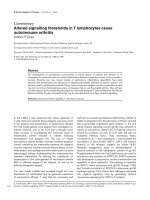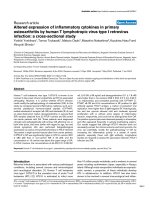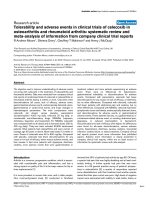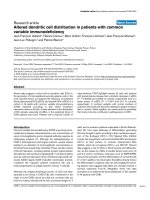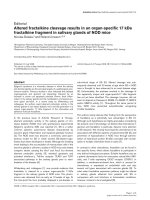Báo cáo y học: "Altered fractalkine cleavage results in an organ-specific 17 kDa fractalkine fragment in salivary glands of NOD mice" pot
Bạn đang xem bản rút gọn của tài liệu. Xem và tải ngay bản đầy đủ của tài liệu tại đây (42.49 KB, 2 trang )
Page 1 of 2
(page number not for citation purposes)
Available online />Abstract
Sjögren’s syndrome is a rheumatic disease in which the salivary
and lacrimal glands are the principal targets of a pathological auto-
immune reaction. Previous studies in mice indicated that delayed
organogenesis and aberrant cell physiology followed by an
increase in acinar cell apoptosis precede chronic focal inflam-
mation in the salivary glands and the manifestation of impaired exo-
crine gland secretion. In a recent study by Wildenberg and
colleagues, the authors report aberrant proteolytic activity in the
salivary glands of non-obese diabetic mice and the generation of a
unique organ-specific 17 kDa fragment of the chemokine and
adhesion molecule fractalkine.
In the previous issue of Arthritis Research & Therapy,
aberrant proteolytic activity in the salivary glands of non-
obese diabetic (NOD) mice with spontaneous experimental
Sjögren’s syndrome (SS) was reported [1]. SS is a rather
common systemic autoimmune disease characterized by
exocrine gland inflammation and impaired glandular function
[2]. The NOD strain has become a commonly used spon-
taneous model for SS in which several SS-related hypo-
theses have been developed or tested. Although the initiating
event leading to the accumulation of mononuclear cells in the
exocrine glands is unknown, studies in NOD mice and related
congenic strains carrying the Aec1 and Aec2 loci showed
aberrant proteolytic activity [3], elevated apoptosis and
activated interferon-γ, Toll-like receptor (TLR)3 and TLR7
associated pathways in the salivary glands prior to mani-
festation of the disease [4].
Wildenberg and colleagues [1] now provide evidence that
fractalkine is cleaved to a unique organ-specific 17 kDa
fragment in the salivary glands of NOD mice. This pheno-
menon was observed from as early as 10 weeks of age. At
this time-point the mice probably displayed a pre-disease or
sub-clinical stage of SS [5]. Altered cleavage was sub-
sequently observed until 20 weeks of age when SS in NOD
mice is thought to have advanced to an overt disease stage
[5]. Unfortunately, the protease involved in the cleavage of
this apparently unique and organ-specific17 kDa fragment
has not yet been identified. The cleavage, however, did not
seem to depend on Caspase-3, ADAM-10, ADAM-17, MMP-2
and/or MMP-9 activity [1]. Throughout the same period of
time, NOD mice presented autoantibodies recognizing
31 kDa fractalkine.
The authors mainly discuss their finding from the perspective
of fractalkine as a potentially new autoantigen in SS [1].
Although such hypotheses are highly speculative considering
the present core of knowledge, we believe that chemokines in
general, and fractalkine in particular, deserve more attention
in SS research. We recently found specific chemokines to be
associated with different aspects of experimental SS [6], and
prevention of hyposalivation in NOD mice through adminis-
tration of heat-shock protein 60 kDa coincided with normali-
zation of multiple chemokine levels in saliva [7].
In contrast to other chemokines, fractalkine can be found in
two specific forms, which allows fractalkine to participate in
very distinct biological processes. Soluble fractalkine acts as
a potent chemotactic factor for monocytes, natural killer (NK)-
cells, and T-cells expressing CX3C receptor (CX3R)1. In
addition, a membrane-anchored form, which is unusual for
chemokines, is expressed on endothelial cells and also
several cell types associated with exocrine glands [8]. To
what extent fractalkine expression patterns might be altered
in salivary glands obtained from patients with SS in
comparison with viral infections or homeostatic conditions,
however, remains to be investigated [8].
Editorial
Altered fractalkine cleavage results in an organ-specific 17 kDa
fractalkine fragment in salivary glands of NOD mice
Nicolas Delaleu
1
and Roland Jonsson
1,2,3
1
Broegelmann Research Laboratory, The Gade Institute, University of Bergen, Haukelandsveien 28, Bergen 5021, Norway
2
Department of Rheumatology, Haukeland University Hospital, Bergen, Jonas Liesvei 65, Bergen 5021, Norway
3
Department of Otolaryngology, Head and Neck Surgery, Haukeland University Hospital, Bergen, Jonas Liesvei 65, Bergen 5021, Norway
Corresponding author: Roland Jonsson,
Published: 31 July 2008 Arthritis Research & Therapy 2008, 10:114 (doi:10.1186/ar2458)
This article is online at />© 2008 BioMed Central Ltd
See related research by Wildenberg et al., />CX3R = CX3C receptor; NK = natural killer; RA = rheumatoid arthritis; SS = Sjögren’s syndrome.
Page 2 of 2
(page number not for citation purposes)
Arthritis Research & Therapy Vol 10 No 4 Delaleu and Jonsson
By acting as an adhesion molecule, membrane-bound frac-
talkine may facilitate extravasation of CX3CR1-expressing
leukocytes [9,10]. In addition, CX3CR1 appears to be a
selective surface marker for leukocyte subsets, which exert
cytotoxic effector functions. Fractalkine may also lead to
increased interferon-γ, tumor necrosis factor-α and granulo-
cyte monocyte colony stimulating factor production by NK-
cells and other cell subsets that have been suggested to play
a role in the initiation phase and pathogenesis of inflammatory
conditions, such as atherosclerosis [10], glomerulonephritis
[9] and rheumatoid arthritis (RA) [9]. Although these dis-
orders are multifactorial in nature, exposure to microbial
agents is thought to play a role in their initiation [2,9,10].
Several viral proteins were reported to bind a broad spectrum
of mediators of the immune system, including fractalkine [8].
Specific gene polymorphisms have been reported to be risk
factors for coronary heart disease [10] and deletion of
CX3CR1 in apolipoprotein E deficient mice reduced athero-
sclerotic lesion formation [10]. Fractalkine has also been
associated with the pathogenesis of RA after fractalkine and
CX3CR1 expression were reported to be upregulated in the
synovium of patients with RA [9]. Supporting the notion of the
disease-modulating activity of fractalkine in RA, administration
of anti-fractalkine antibodies ameliorated experimental RA [9].
With regard to diseases involving the kidneys, a viral
fractalkine antagonist reduced kidney inflammation and
proteinurea in the Wistar-Kyoto crescentic glomerulonephritis
model [9]. In concordance, anti-CX3CR1 blocked lympho-
cytic infiltration and the development of subsequent stages of
glomerulonephritis in these rats [9]. In MRL
lpr
mice a
truncated fractalkine analogue with the capability of antago-
nizing the actions of fractalkine also significantly ameliorated
several aspects of lupus nephritis and vasculitis [9].
The findings reported by Wildenberg and colleagues add the
aspect of organ-specific cleavage of fractalkine to its
potential role in a specific autoimmune condition. Unfortu-
nately, the report does not address the effect of altered
cleavage on fractalkine’s biological activities, for example,
chemotaxis. Based on the results presented it is therefore
difficult to speculate if fractalkine, through altered cleavage,
might be rendered either more potent or less efficient with
regard to certain of its actions. The study by Wildenberg and
colleagues provides, however, a rationale for conducting
such functional studies in the future. In parallel, it would be
interesting to address if the described autoantibodies might
have the potential to modulate fractalkine related inflam-
matory processes.
Conclusion
The recent study by Wildenberg and colleagues provides
insight into the role of fractalkine in an experimental model of
SS, which, due to its dual role as chemoattractant and
adhesion molecule, might play a crucial role in the initiation,
accumulation and retention of inflammatory cells in the
salivary glands. This corresponds to properties of fractalkine
reported in other inflammatory diseases and rheumatic
conditions. In SS, however, the role of fractalkine in the
etiology and pathogenesis of the disease deserves to be
studied further through direct manipulation of pathways
involving fractalkine. More experimental evidence is also
required to establish anti-fractalkine autoantibodies as a
marker for SS or even to define a specific role for such
autoantibodies in the pathogenesis of SS.
Competing interests
The authors declare that they have no competing interests.
References
1. Wildenberg ME, van Helden-Meeuwsen CG, Drexhage HA,
Versnel MA: Altered fractalkine cleavage potentially promotes
local inflammation in NOD salivary gland. Arthritis Res Ther
2008, 10:R69.
2. Delaleu N, Jonsson MV, Appel S, Jonsson R: New concepts in
the pathogenesis of Sjögren’s syndrome. Rheum Dis Clin N
Am 2008, in press.
3. Robinson CP, Yamachika S, Alford CE, Cooper C, Pichardo EL,
Shah N, Peck AB, Humphreys-Beher MG: Elevated levels of
cysteine protease activity in saliva and salivary glands of the
nonobese diabetic (NOD) mouse model for Sjögren syn-
drome. Proc Natl Acad Sci USA 1997, 94:5767-5771.
4. Killedar SJ, Eckenrode SE, McIndoe RA, She JX, Nguyen CQ,
Peck AB, Cha S: Early pathogenic events associated with Sjö-
gren’s syndrome (SjS)-like disease of the NOD mouse using
microarray analysis. Lab Invest 2006, 86:1243-1260.
5. Jonsson MV, Delaleu N, Brokstad KA, Berggreen E, Skarstein K:
Impaired salivary gland function in NOD mice: association
with changes in cytokine profile but not with histopathologic
changes in the salivary gland. Arthritis Rheum 2006, 54:2300-
2305.
6. Delaleu N, Immervoll H, Cornelius J, Jonsson R: Biomarker pro-
files in serum and saliva of experimental Sjögren’s syndrome:
associations with specific autoimmune manifestations. Arthri-
tis Res Ther 2008, 10:R22.
7. Delaleu N, Madureira AC, Immervoll H, Jonsson R: Inhibition of
experimental Sjögren’s syndrome through immunization with
heat-shock protein 60 kDa and its peptide amino acide 437-
460. Arthritis Rheum 2008, in press.
8. Latchney LR, Fallon MA, Culp DJ, Gelbard HA, Dewhurst S:
Immunohistochemical assessment of fractalkine, inflamma-
tory cells, and human herpesvirus 7 in human salivary glands.
J Histochem Cytochem 2004, 52:671-681.
9. Umehara H, Tanaka M, Sawaki T, Jin ZX, Huang CR, Dong L,
Kawanami T, Karasawa H, Masaki Y, Fukushima T, Hirose Y,
Okazaki T: Fractalkine in rheumatoid arthritis and allied condi-
tions. Mod Rheumatol 2006, 16:124-130.
10. Umehara H, Bloom ET, Okazaki T, Nagano Y, Yoshie O, Imai T:
Fractalkine in vascular biology: from basic research to clinical
disease. Arterioscler Thromb Vasc Biol 2004, 24:34-40.


